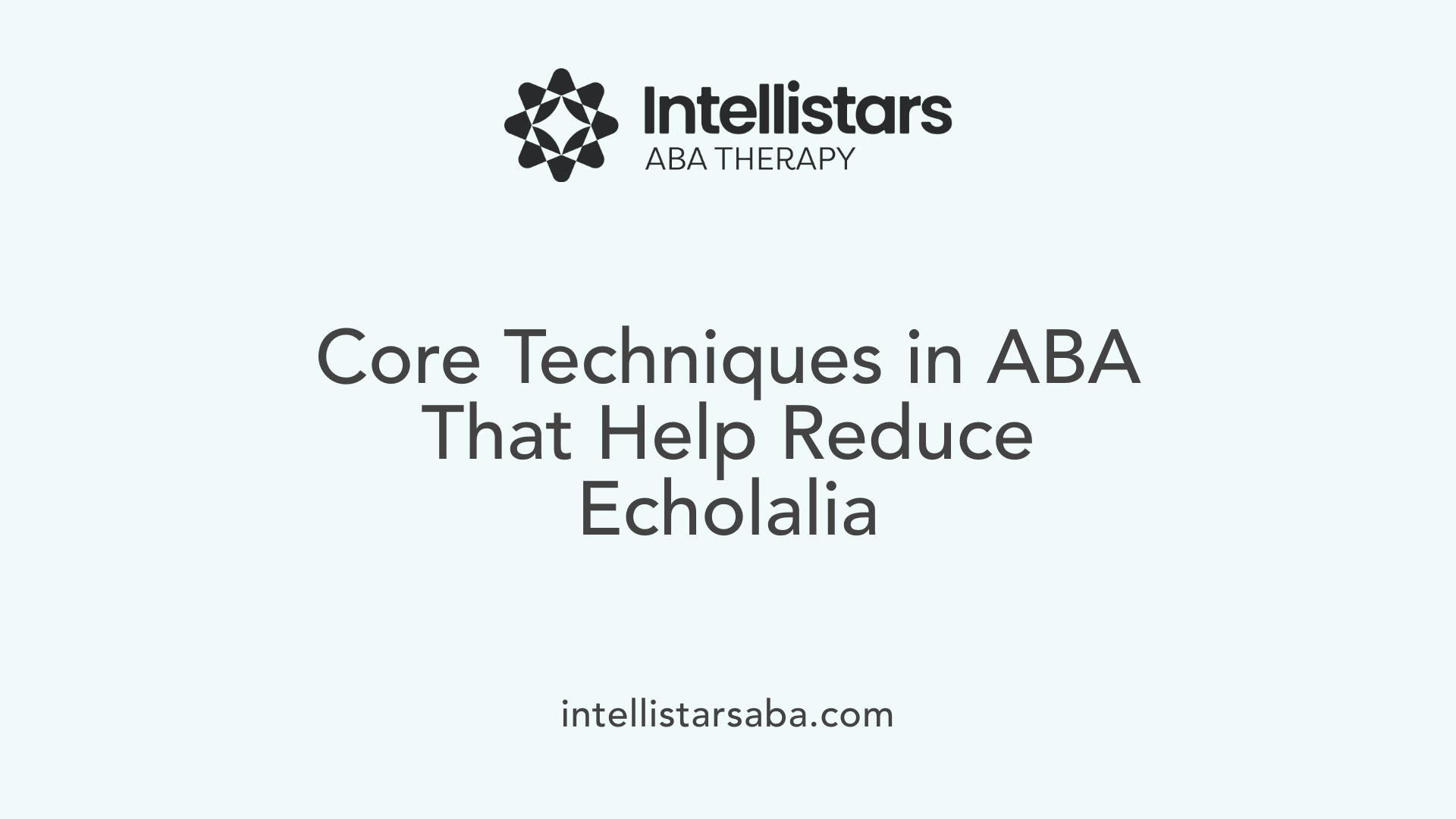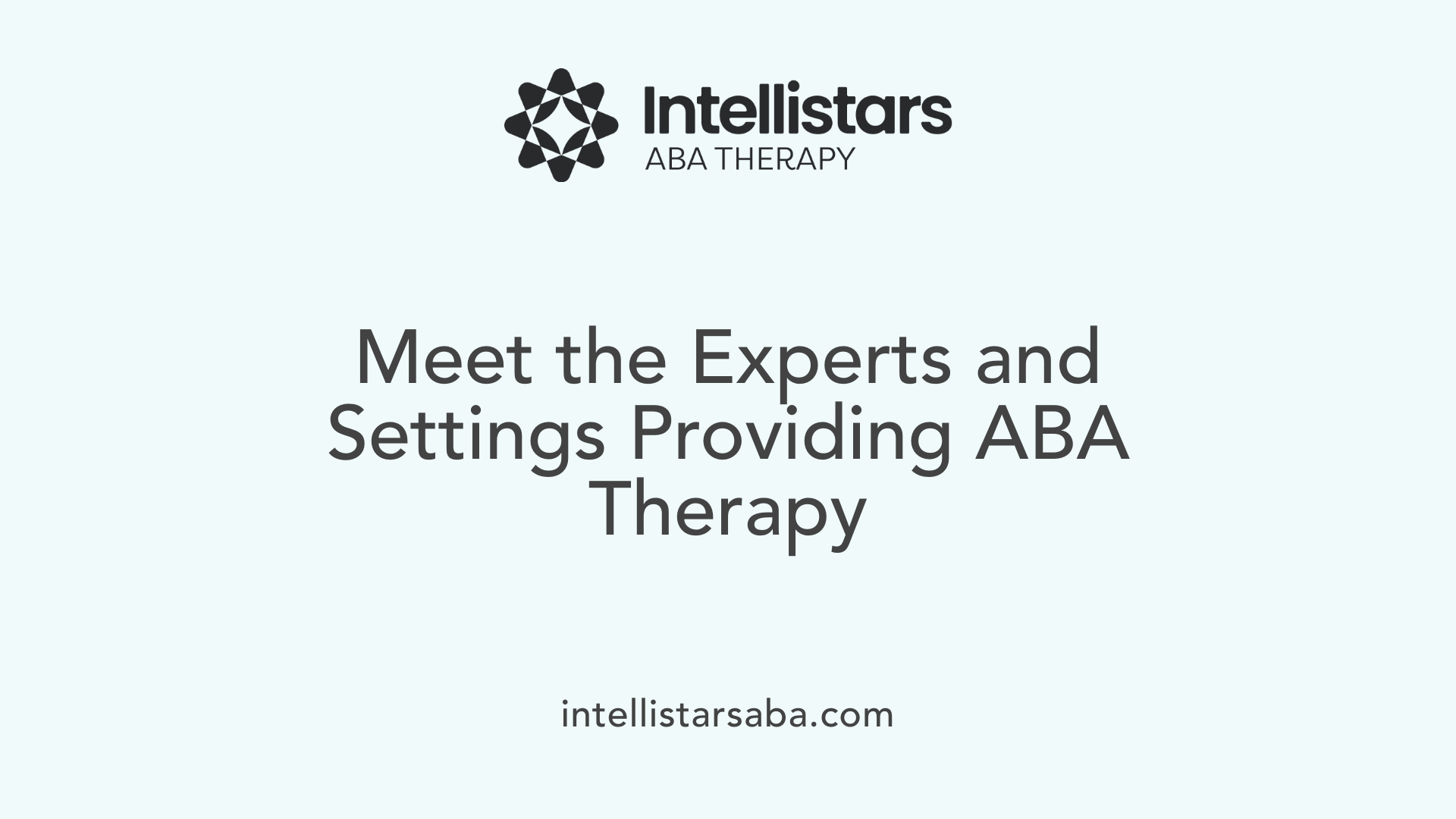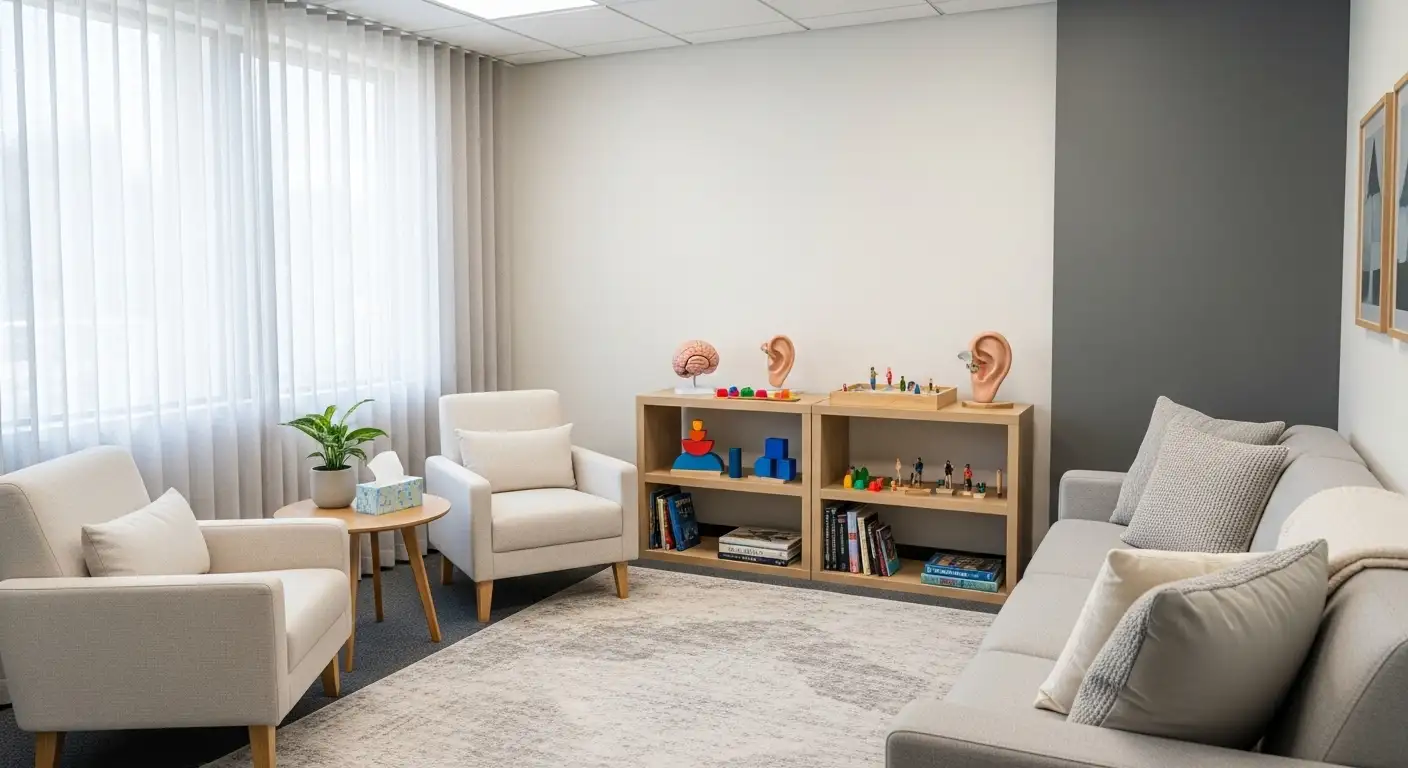Understanding Echolalia and ABA Therapy
Echolalia, the repetitive echoing of words or phrases, is a common communication pattern in children with autism spectrum disorder (ASD). While it can serve multiple functions, including communication and self-regulation, reducing disruptive or non-functional echolalia can significantly improve social interactions and communication skills. Applied Behavior Analysis (ABA) therapy, a scientifically supported approach, uses behavior analytic techniques to address echolalia effectively. This article explores how ABA methods can be tailored to reduce echolalia in children with ASD, supporting enhanced communication and adaptive behaviors.
What Is Applied Behavior Analysis (ABA) Therapy?

What is Applied Behavior Analysis (ABA) therapy?
Applied Behavior Analysis (ABA) therapy is a science-based approach that focuses on understanding and modifying human behavior. It relies on psychological principles such as reinforcement, prompting, and fading to encourage positive behaviors and reduce unwanted ones. ABA systematically examines the relationships between antecedents (what happens before a behavior), behaviors, and consequences to develop effective interventions.
How are ABA programs individualized?
ABA interventions are tailored to meet the unique needs of each individual. A Board Certified Behavior Analyst (BCBA) conducts a thorough assessment to understand the person's abilities, challenges, and goals. Based on this, an individualized treatment plan is developed targeting areas such as communication, social skills, self-care, and academics. This personalized approach ensures that therapy is relevant and effective for the learner.
What are the core goals of ABA?
The primary goals of ABA therapy include enhancing communication and social interaction skills, teaching functional behaviors, and reducing challenging behaviors. ABA also helps develop adaptive skills necessary for daily living. By using techniques like positive reinforcement, behavior chaining, and visual supports, ABA fosters improvements in language, socialization, and flexibility.
Where is ABA implemented?
ABA therapy can be delivered in various settings such as clinics, schools, and homes. Its versatility allows it to adapt to different environments while maintaining consistent, data-driven strategies. Through collaboration with families and multidisciplinary teams, ABA provides support that generalizes across contexts to promote sustained progress in socially significant behaviors.
Benefits of ABA Therapy for Individuals with Autism and Echolalia

How does ABA therapy benefit individuals with autism?
ABA therapy offers personalized, evidence-based interventions that focus on enhancing communication, social skills, and everyday living skills for individuals with autism. Through techniques such as positive reinforcement, prompting, and visual supports, ABA encourages the development of meaningful behaviors while reducing problematic ones like echolalia.
Early and intensive ABA interventions are particularly impactful, leading to notable improvements in language abilities, social interactions, and independence. By systematically teaching functional communication and replacement behaviors—for example, using verbal requests or picture exchange systems—ABA reduces frustration-driven behaviors and supports smoother social exchanges.
Moreover, ABA helps individuals build adaptive and life skills, such as self-care, coping with sensory sensitivities, and organizing tasks. These skills promote greater autonomy and integration within family, school, and community settings.
Reduction of problematic behaviors such as echolalia
Echolalia, a common repetitive vocal behavior in children with autism, can be effectively decreased using behavior analytic methods grounded in operant conditioning—such as differential reinforcement and script training combined with visual cues. These strategies not only reduce echolalia but also encourage the use of functional, spontaneous communication.
Enhancement of communication and social skills
ABA therapy improves expressive and receptive language abilities, helping to increase the child’s capability for social interaction. Interventions like verbal modeling with positive reinforcement and visual supports assist in building complex communication skills and appropriate social behaviors.
Improvement in adaptive and life skills
Through individualized teaching strategies using task analysis, visual schedules, and gradual exposure techniques, ABA aids in mastering functional daily living skills. This fosters behavioral flexibility, executive functioning, and coping mechanisms necessary for navigating changes and challenges in everyday environments.
Importance of early intensive intervention
Beginning ABA therapy at an early age, often guided by a Board Certified Behavior Analyst (BCBA), maximizes long-term benefits. Early Start Denver Model (ESDM) and Pivotal Response Treatment (PRT) are examples of ABA approaches that use naturalistic, play-based activities to effectively engage young children and support multiple developmental goals simultaneously.
ABA involves continuous data collection and collaboration with multidisciplinary teams to ensure ethical, individualized treatment plans tailored to each child's needs. This comprehensive approach leads to sustained behavioral improvements, generalization of skills, and overall enhanced quality of life for individuals with autism and echolalia.
Core ABA Principles and Techniques Relevant to Echolalia Reduction

What are the core principles and techniques used in ABA therapy?
Applied Behavior Analysis (ABA) therapy is based on the scientific study of behavior and learning principles. Central to ABA is the use of positive reinforcement, which encourages desired behaviors by rewarding them, helping increase communication, social skills, and functional behaviors while reducing unwanted actions.
ABA relies on behavioral analysis using the antecedent-behavior-consequence (ABC) model to understand triggers and results of actions. Data collection plays a critical role to track progress and adjust interventions.
Specific techniques used in ABA include:
- Prompting and fading: Providing cues or assistance to elicit behaviors which are gradually reduced, promoting independence.
- Modeling: Demonstrating behaviors for the learner to imitate, often combined with role-playing.
- Differential reinforcement: Reinforcing desired behaviors while reducing reinforcement for behaviors like echolalia.
Structured teaching methods such as Discrete Trial Training (DTT) involve breaking skills into small, manageable steps taught through repeated trials with reinforcement. This method avoids punishment and emphasizes clear instruction and feedback.
Script fading uses guided social scripts to support social interaction and communication skills, which is particularly useful for children displaying echolalia.
Visual supports such as charts, schedules, and the Picture Exchange Communication System (PECS) help children anticipate routines and communicate effectively.
Functional Communication Training (FCT) teaches functional language or alternative communication to replace repetitive or echolalic speech, reducing frustration and improving interaction.
Overall, ABA is highly individualized. A Board Certified Behavior Analyst (BCBA) develops tailored plans using these techniques, ensuring treatment fits each child's unique needs and promotes meaningful, lasting behavioral improvements.
Evidence Supporting ABA Interventions in Reducing Echolalia

Review of Peer-Reviewed Studies on Echolalia and ABA
A comprehensive review analyzed 11 peer-reviewed studies that incorporated behavior analytic components aimed at reducing echolalia in children with autism spectrum disorder (ASD). Among these studies, nine demonstrated positive outcomes, successfully reducing echolalic behavior in participants. This strong showing underscores the promise of Applied Behavior Analysis (ABA) interventions for addressing echolalia.
Effectiveness of Behavior Analytic Interventions Like Cues-Pause-Point and Script Training
Certain interventions have conclusive evidence supporting their effectiveness. Techniques such as cues-pause-point, differential reinforcement of lower rates of behavior, script training combined with visual cues, and verbal modeling complemented by positive reinforcement stand out. These methods leverage operant conditioning principles to modify echolalia by encouraging more functional communication.
Importance of Operant Conditioning Concepts
Behavior analytic approaches are firmly grounded in operant conditioning, emphasizing reinforcement and prompting strategies. Understanding the operant function of echolalia—meaning the purpose or outcome the behavior serves for the child—is crucial for tailoring effective interventions. While the reviewed studies did not explicitly assess operant functions, the overarching ABA framework stresses this as an essential step for optimal outcomes.
Sustainability of Behavior Changes: Maintenance and Generalization
Some studies reported maintenance and generalization of behavioral improvements, observing positive effects months after intervention concluded. This suggests that ABA techniques not only reduce undesired echolalia short term but also support enduring behavior change, increasing the likelihood that gains will translate into everyday settings.
What Evidence Supports the Effectiveness of ABA Therapy for Autism?
Extensive research over the past four decades validates ABA's effectiveness for individuals with autism, including those exhibiting echolalia. Diverse study designs—from randomized controlled trials to detailed behavior analyses—consistently show improvements in communication, social interaction, and adaptive behaviors. The identification and targeting of behavior functions through functional behavior assessments enable ABA to deliver customized, meaningful interventions. Meta-analyses and evidence-based reviews affirm ABA as a highly effective treatment option that enhances language, IQ, social skills, and overall functioning in ASD.
| Topic | Summary | Additional Details |
|---|---|---|
| Peer-Reviewed Studies on Echolalia & ABA | Review of 11 studies, 9 showing successful echolalia reduction | Supports ABA's promise for echolalia interventions |
| Effective ABA Techniques | Cues-pause-point, script training, reinforcement, verbal modeling | Based on operant conditioning principles |
| Role of Operant Conditioning | Emphasizes understanding behavior functions for tailored interventions | Reviewed studies did not focus on function but highlight its value |
| Maintenance and Generalization of Gains | Some studies observed long-term behavioral improvements | Sustained effects boost real-life applicability |
| Scientific Evidence for ABA in Autism | Four decades of research show consistent improvements in communication and social skills | Recognized by meta-analyses and functional behavior assessments |
Who Provides ABA Therapy and How Is It Delivered?

Roles of BCBAs and Therapy Technicians
ABA therapy services are primarily delivered by Board Certified Behavior Analysts (BCBAs), professionals trained in analyzing behavior and designing individualized interventions. BCBAs assess each child's unique needs and develop tailored treatment plans. Supporting them are therapy technicians or Certified Behavior Technicians (CBTs), who implement these plans during day-to-day sessions, employing reinforcement and prompting techniques while carefully collecting data to track progress.
Individualized Treatment Plan Development
Treatment plans are customized based on thorough assessments performed by BCBAs. These plans incorporate specific goals related to communication, social interaction, and behavior reduction linked to echolalia and other repetitive behaviors common in autism spectrum disorder (ASD). The plans adapt continuously, relying on regular data analysis to fine-tune interventions for maximal effectiveness.
Collaboration with Families and Multidisciplinary Teams
Effective ABA therapy extends beyond direct therapy sessions, involving active collaboration with families and other professionals such as speech therapists, occupational therapists, educators, and healthcare providers. This multidisciplinary teamwork ensures consistent strategy application across environments and supports skill generalization. Family training empowers caregivers to reinforce techniques at home, increasing the likelihood of maintenance and long-term gains.
Settings Including Clinics, Homes, and Schools
ABA therapy can be delivered across versatile settings according to individual requirements. Clinics provide structured environments for focused intervention; many programs also occur in home settings to ensure ecological validity and ease daily generalization. Additionally, schools offer inclusive platforms for ABA integration within educational activities, promoting social and functional skills alongside peers.
Together, these components demonstrate that ABA therapy providers form a coordinated, skilled network dedicated to improving outcomes for children with ASD by delivering evidence-based interventions in collaborative, supportive contexts.
Tailored Strategies and Parent Involvement in Managing Echolalia Through ABA
How does Functional Communication Training (FCT) help reduce echolalia?
Functional Communication Training (FCT) is an essential strategy in ABA therapy that teaches children with ASD to express their needs effectively. By replacing echolalia with functional requests or expressions, FCT helps reduce frustration and behavioral outbursts. When children learn to use words, gestures, or picture exchange systems to communicate, they become less reliant on repeated speech and gain more control over social interactions.
What role do visual supports, social stories, and role-playing play?
Visual aids such as pictures, schedules, and charts provide predictability, helping children anticipate what comes next and lessening anxiety. Social stories offer personalized, clear narratives that prepare children for new or challenging situations with positive framing. Role-playing allows rehearsal of new routines or social scenarios, offering a safe space to practice and become comfortable with changes.
How are positive reinforcement and gradual exposure used to promote flexibility?
Positive reinforcement, including praise or simple rewards like stickers or snacks, motivates children to embrace new behaviors and respond better to changes. Gradual exposure breaks down transitions or unfamiliar situations into manageable steps, preventing overwhelm and fostering adaptability over time.
Why is parental training important and how does it support generalization?
Parents play a vital role in reinforcing strategies outside of therapy sessions. Training enables them to use interventions consistently at home, promoting the generalization of skills across settings. This collaboration ensures that communication gains and behavioral improvements sustain and extend into daily life.
What coping tools and sensory integration techniques assist children?
ABA incorporates calming strategies such as sensory toys, deep breathing exercises, and designated quiet spaces. These tools help children self-regulate when faced with stressors linked to echolalia or transitions, enhancing their ability to cope and remain engaged.
By tailoring these strategies to individual needs and involving parents actively, ABA therapy effectively addresses echolalia, supporting communication growth and behavioral flexibility in children with ASD.
Moving Forward with ABA to Address Echolalia
Addressing echolalia through Applied Behavior Analysis offers a promising pathway toward improved communication and functional language for children with ASD. The combination of evidence-based principles, individualized assessment, and proven techniques such as reinforcement, prompting, and functional communication training facilitates meaningful behavioral change. Collaboration between qualified ABA providers, families, and multidisciplinary professionals ensures interventions are personalized and sustainable. With ongoing research and practice refinement, ABA continues to evolve as an essential tool in supporting children with autism to reduce echolalia and foster greater independence and social engagement.
References
- Treatment of Echolalia in Individuals with Autism Spectrum ...
- Applied Behavior Analysis (ABA)
- ABA Therapy Techniques to Help Your Child Handle Change
- ABA Techniques: Strategies for Behavior Analysts - GSEP Blog
- What Challenges Can ABA Therapy Address in Autism ...
- How To Address Challenging Behaviors With ABA Therapy
- Scientific Support for Applied Behavior Analysis






